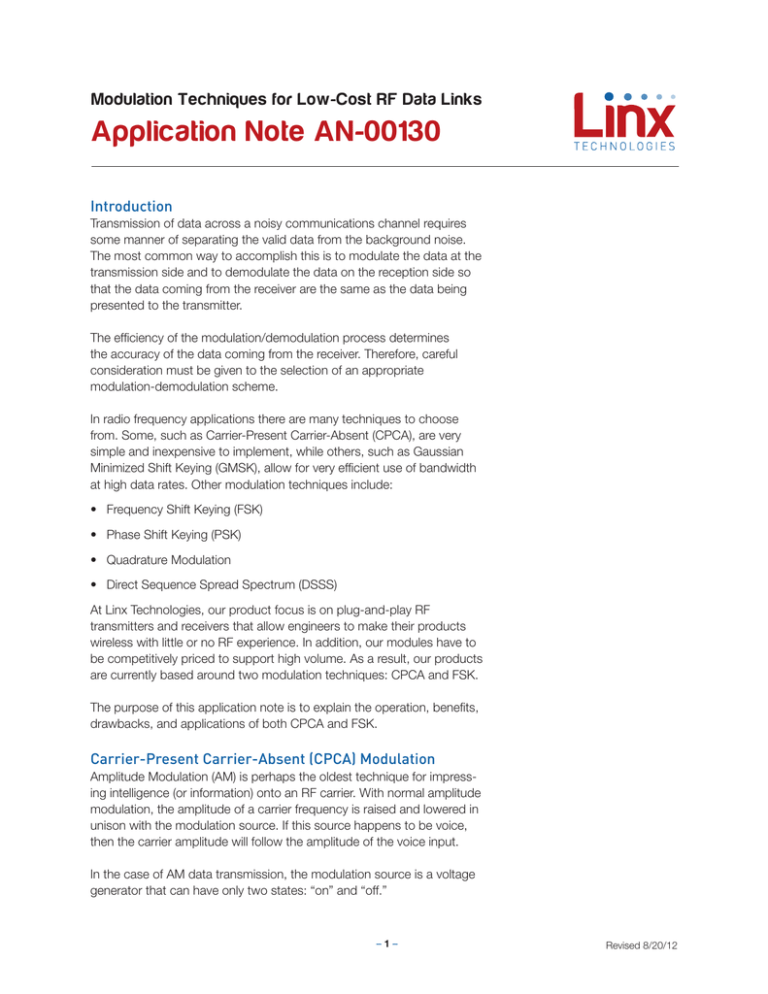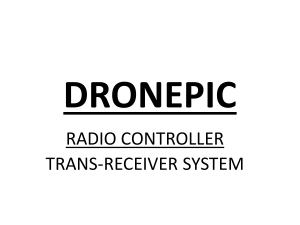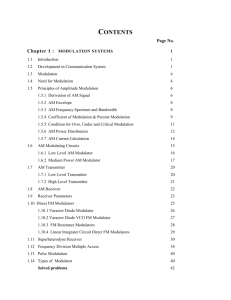Application Note AN-00130
advertisement

Modulation Techniques for Low-Cost RF Data Links Application Note AN-00130 Introduction Transmission of data across a noisy communications channel requires some manner of separating the valid data from the background noise. The most common way to accomplish this is to modulate the data at the transmission side and to demodulate the data on the reception side so that the data coming from the receiver are the same as the data being presented to the transmitter. The efficiency of the modulation/demodulation process determines the accuracy of the data coming from the receiver. Therefore, careful consideration must be given to the selection of an appropriate modulation-demodulation scheme. In radio frequency applications there are many techniques to choose from. Some, such as Carrier-Present Carrier-Absent (CPCA), are very simple and inexpensive to implement, while others, such as Gaussian Minimized Shift Keying (GMSK), allow for very efficient use of bandwidth at high data rates. Other modulation techniques include: • Frequency Shift Keying (FSK) • Phase Shift Keying (PSK) • Quadrature Modulation • Direct Sequence Spread Spectrum (DSSS) At Linx Technologies, our product focus is on plug-and-play RF transmitters and receivers that allow engineers to make their products wireless with little or no RF experience. In addition, our modules have to be competitively priced to support high volume. As a result, our products are currently based around two modulation techniques: CPCA and FSK. The purpose of this application note is to explain the operation, benefits, drawbacks, and applications of both CPCA and FSK. Carrier-Present Carrier-Absent (CPCA) Modulation Amplitude Modulation (AM) is perhaps the oldest technique for impressing intelligence (or information) onto an RF carrier. With normal amplitude modulation, the amplitude of a carrier frequency is raised and lowered in unison with the modulation source. If this source happens to be voice, then the carrier amplitude will follow the amplitude of the voice input. In the case of AM data transmission, the modulation source is a voltage generator that can have only two states: “on” and “off.” –1– Revised 8/20/12 When the modulation source is “on” representing a logic high or a ‘1’ in binary terms, the carrier amplitude is at its maximum, and when the modulation source is “off” representing a logic low or a binary ‘0’, the carrier amplitude is at its minimum. This method of AM modulation is referred to by multiple designations, among them OOSK (On-Off Shift Keying) OOK, (On-Off Keying) and CPCA (Carrier-Present Carrier-Absent). Linx uses the CPCA designation because we feel it most accurately describes the modulation method. Carrier ON Data OFF Figure 1: CPCA Modulation Envelope The modulation depth is defined as the difference in output power between the “on” and “off” states. For instance, if the output power is 0dBm when the modulation source is “on” and –110dBm when the modulation source is “off”, then the modulation depth is 110dB. This is an important parameter of any CPCA transmitter because it determines the possible sensitivity of the receiver and, therefore, the ultimate range over which the data link will operate. Consider this. A CPCA receiver has a sensitivity of –105dBm. Therefore, the receiver will see any carrier in its passband with an amplitude that is greater than –105dBm as an indication of a transmitted “on” condition (or a ‘1’ in binary terms). The modulation depth must be greater in magnitude than the difference between this sensitivity and the output power capability of the transmitter. For example, if the transmitter had an output power of 0dBm and a modulation depth of 60dB, then the transmitter would output –60dBm of power in its “off” state. However, the receiver would “see” the carrier at this power level and consider it an “on” condition because the power of the carrier is above the sensitivity of the receiver. Therefore, if the modulation depth is not great enough, the carrier may never drop below the sensitivity of the receiver and the receiver, and accordingly will always indicate an “on” condition. Another important parameter of a CPCA transmitter is its “on” condition output power. This is power the transmitter will deliver into a 50-ohm load when the modulation source is “on”. FCC regulations limit this power depending on the center frequency and operational parameters. A direct benefit of CPCA over Frequency Modulation (FM) is that the FCC will allow higher peak output powers since the carrier is not always present. For example, with a 50% duty cycle, a CPCA transmitter can output twice the power of an FM transmitter. For more information, refer to FCC CFR 47 Part 15.231. The most common circuit used to detect a CPCA signal is the simple diode detector shown in Figure 2. The diode and a subsequent low-pass –2– Application Note AN-00130 filter acts to remove the carrier and leave only the original data intact. Amplification is used on the output of the diode detector to limit and shape the data back to its original form. CARRIER IN DIODE DETECTOR RECOVERED DATA OUT Figure 2: Diode Detector Circuit CPCA modulation has many benefits that make it very practical for some applications. Low cost: By accommodating the inherent inaccuracies of SAW resonators, CPCA transmitters and receivers can take advantage of the low cost of a SAW-based design. Low power consumption: When the modulation source is off, the transmitter draws virtually no power. In the “on” condition, a SAW based design typically draws ½ to 1⁄3 the power of a synthesized design. For a 50% duty cycle modulation waveform, a CPCA transmitter can draw as little as 2–3mA. Small size: CPCA is a very simple modulation technique, and thus requires fewer components to be implemented. There are also several limitations of CPCA that the designer should consider: Low data rate: A typical SAW based CPCA transmitter is limited to less than 10k bits/second. This limitation is a direct function of the start-up time of the oscillator. Since SAW resonators have a fairly high loaded Q, their start-up time can be as high as 20 microseconds. Poor noise immunity: Any noise in the passband of the receiver that is above the receiver’s sensitivity will interfere with data transmission. In contrast, this type of amplitude noise does not affect a properly designed FSK receiver. CPCA is best used in situations where cost,operating distance and power efficiency are the overriding concerns. If the primary requirement is data rate/integrity, noise performance or channelization, then FSK may be a better choice. –3– Application Note AN-00130 Frequency Shift Keying (FSK) Modulation FSK is a simplified form of FM. For good noise performance and high bandwidth operation, FSK is the modulation technique of choice. In true FM, an analog signal is represented with a linear frequency deviation from center. FSK is a binary form of frequency modulation that uses hard shifts between deviant frequencies to represent the data originally impressed on the carrier. The magnitude of frequency shift is directly related to the magnitude of the modulation source voltage. Carrier ON Data OFF Figure 3: FSK Modulation The modulation source is allowed two states: “on” and “off”. When the modulation source is “off”, the carrier frequency is shifted down from the center frequency. When the modulation source is “on”, the carrier frequency is shifted up from the center frequency. The amount that the carrier frequency is shifted is referred to as the frequency deviation. "OFF" "ON" Fo Fc Fdev=(Fc-Fo) Figure 4: FSK Modulation States and Frequency Deviation Unlike CPCA, a carrier is always present with FSK modulation. This affords the designer several benefits. First, the carrier will load the receiver at all times, providing greatly increased noise immunity. Secondly, the strength (or amplitude) of the carrier can be used to determine the quality of the incoming signal. A Received Signal Strength Indicator (RSSI) circuit is used for this purpose. It outputs a voltage that corresponds to signal strength, and has a typical dynamic range of 70–90dB. A drawback of the continuous carrier is that the transmitter is always drawing power and generating an output. Therefore, the transmitter will ultimately require a higher supply current than CPCA-based systems. In addition, the output power cannot be legally increased in countries (such as the US) where power measurements are averaged over time since full output power is always present. –4– Application Note AN-00130 FSK is a Non-Return to Zero (NRZ) modulation method. This means that the non-modulated condition is between the “off” and “on” condition. In other words, the carrier should never be at the center frequency when modulation is present. The benefit here is noise immunity. Hysteresis can be applied to the detector, eliminating the effect of spurious frequency modulation generated from sources other than the data stream. Since FSK relies on frequency change and not amplitude change to indicate data states, an FSK receiver is inherently immune to amplitude noise. This is of great importance in bands that are extremely crowded and have a high potential for near-band interference. This increased noise immunity suggests a potential for higher data rates. In fact, FSK systems can achieve significantly higher data rates than their CPCA counterparts, albeit at the sacrifice of cost and power consumption. Data rates up to 100kbps are readily achieved. Although FSK systems are immune to amplitude noise, they are very sensitive to frequency noise. That is, unwanted frequency changes caused by incircuit sources will ultimately cause bit errors in the data stream. As mentioned previously, simple hysteresis can be applied to the FSK detector to remove some of this noise, but a stable frequency source must still be used to ensure good noise immunity. While SAW resonators work extremely well for low baud rate applications at lower frequencies, their inherent frequency inaccuracies make them poorly suited to high performance FSK applications. Thus, a synthesized source based on a crystal reference must be used. It is a well-known fact that crystals are superior to SAW resonators with regard to loaded Q and frequency accuracy. However, crystals cannot be operated in their fundamental mode at UHF. Instead, a crystal is used with a Phase-Locked-Loop (PLL) to synthesize a high frequency. While this technique is expensive and requires additional board space, it is the best method for attaining the tight frequency control necessary to achieve high data rates and noise immunity. It also affords an added benefit: channelization. By using a divide-by-n PLL, the synthesized frequency can be set by changing the values of the internal counters. This allows a user to select from multiple channels, separated by some nominal frequency. One transmitter or receiver can then transmit on many separate channels. FSK modulation for the transmission of data has many features and limitations to consider. Among the benefits of FSK are: • Higher data rates • Continuous carrier presence • Better noise immunity • Channelization –5– Application Note AN-00130 Limitations of FSK are: • Higher cost • Higher power consumption • Larger size • Lower allowable output power FSK modulation should be used for performance-oriented applications where data rate, noise immunity and channelization are of primary concern. Copyright © 2012 Linx Technologies 159 Ort Lane, Merlin, OR, US 97532 Phone: +1 541 471 6256 Fax: +1 541 471 6251 www.linxtechnologies.com –6– Application Note AN-00130



